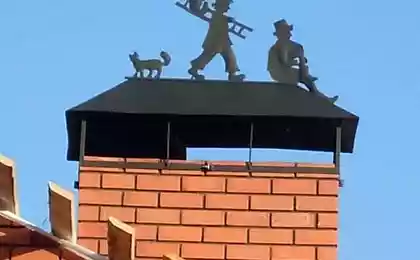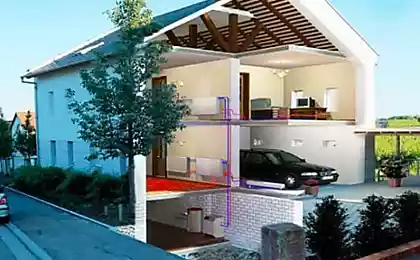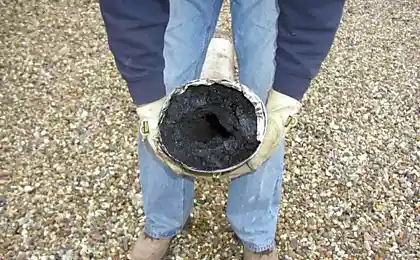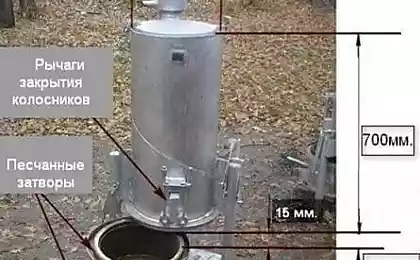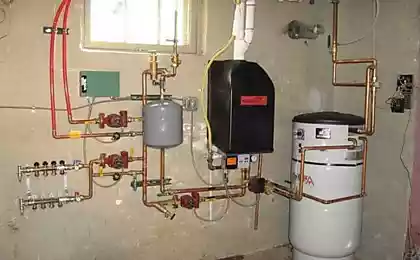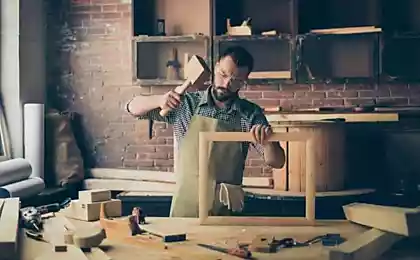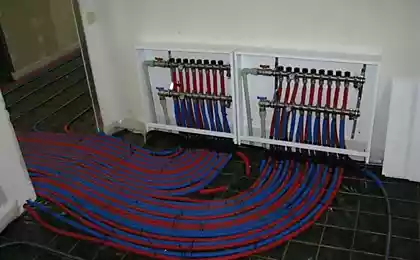595
The device working principle and installation of the coaxial chimney
Independent heating system, if it does not work on electricity, can't do without the outlet of the combustion device. If earlier it could only be a traditional fireplace, but now there are other options, more efficient and practical. Installation of the coaxial chimney gives a lot of benefits, additionally, it can be produced in existing building. What is so good chimney coaxial type? We will investigate.
Coaxial duct: what is itIn the technique the term "coaxial" means that there are two objects of any kind, arranged so that one is inside the other. Therefore, the coaxial type chimney is a double-loop construction, made of pipes of different diameters. Inside the larger element is less detail. The distance between them is strictly the same throughout the length of the design, including all bends and elbows.
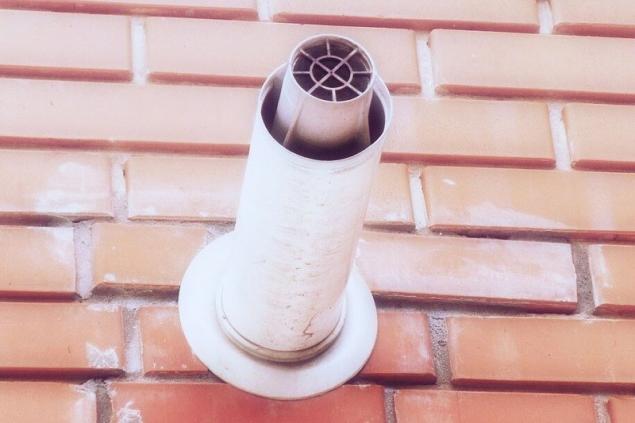
To this end, the tubes are a special jumper. In the context of such a system looks like a pair of concentric rings. Channel for the removal of smoke is the inner, smaller diameter pipe. Through a gap between two parts inside of the heater from outside is supplied is required to support combustion oxygen. Thus, gases within the system are moved in opposite directions.
Design features of the coaxial flue and give him the opportunity to perform direct functions. The device provides a constant flow of air that is needed to sustain the combustion process. In addition, it successfully removes from the boiler the products of combustion. With an overall length of usually less than two metres. This files most often mounted system, oriented horizontally, but some vertical variation.
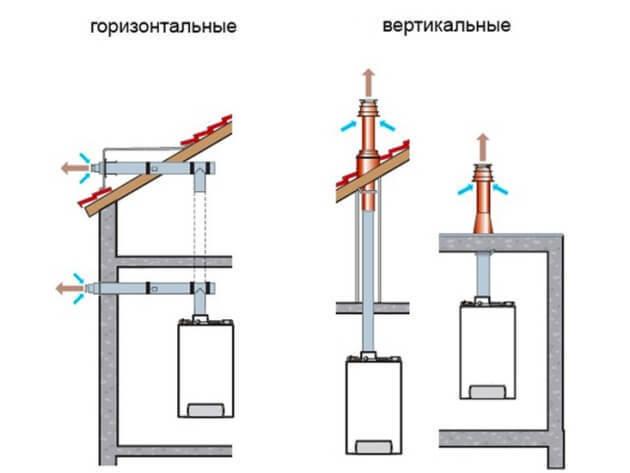
The chimney of the coaxial type is a system of modules that allows you to make chimneys of various configurations taking into account the architectural features of the building. All the elements included in the system are standardized, which greatly simplifies their installation.
The standard package consists of several modules:
For the manufacture of parts for coaxial ducts are used galvanized or stainless steel. It is resistant to high temperatures, durable and lightweight. Some models are made of aluminium alloy or heat-resistant plastic. For joints, apply the sealers made of heat-resistant polymers capable of withstanding temperatures of the order of 230-250°.
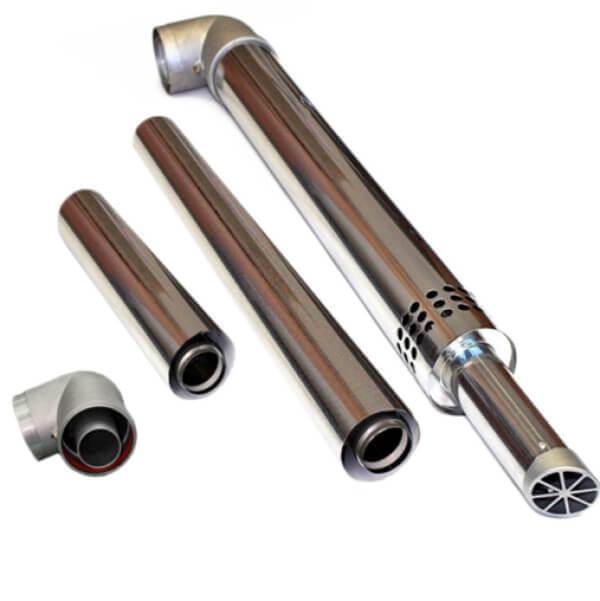
Types of chimneys coaxial type
There are several types of design "pipe in pipe". A detailed look at each of them.
External and internal systems
All coaxial chimneys depending on their location divided into external and internal. The first are on the outside of the building and are fixed directly on the facade. Given that such designs are somewhat spoil the appearance of the building, they try to place on the inner sides of the building. A distinctive feature of the chimney external type – easy maintenance and installation.
Internal structure mounted in a specially laid mines that take place inside the building and is separated from the living quarters. In some cases, as these mines can be used in traditional chimneys. It is important that their design and dimensions fully meet the modern requirements of fire safety. The internal system is quite complicated to operate and install.
Non-insulated and insulated devices
In the cold, especially in extreme cold, the canal, feeding into the system the air can freeze. In this case, the amount of oxygen entering the combustion chamber is dramatically reduced, which leads to deterioration of the heater. In some cases, to stop. Therefore, where low temperatures last for quite a long period of time, and where frequent winter frosts, it is recommended to install insulated system.
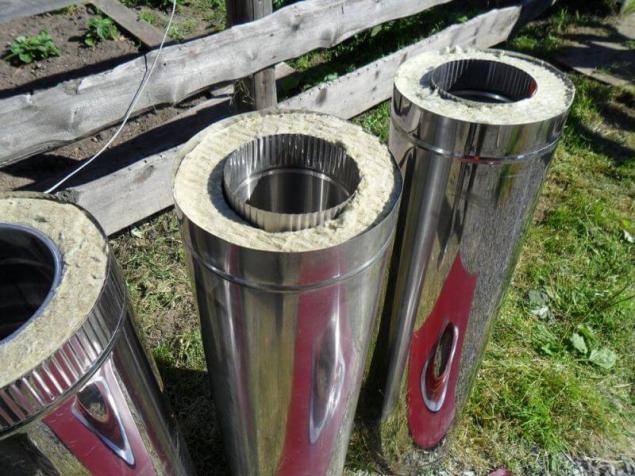
Coaxial duct insulated type different from the presence of another pipe. The system looks like three nested in each other part. The space between the two extreme elements is insulated. To this end, it is filled with any suitable insulation. This protects the air passage from icing and freezing.
Horizontal or vertical output
Initially, coaxial chimneys designed as a horizontally oriented system, but in practice this arrangement is not always possible. Most of the chimneys of this type represent a mixed design. They can be vertically oriented, and horizontal sections. This is due to the location of the heater in the building. In some cases it is possible to use vertical chimneys, but only for boilers without forced draft.
Collective and individual designs
For service one heating device uses individual coaxial chimneys. It is a simple system without branching, which may have a different configuration. For multiple boilers mounted a collective chimney. This silo system with multiple branches. In addition, each of the branches goes to one of the heat generators. This design can only be vertical.

Why choose coaxial system
Design features of the coaxial flue and give him the opportunity to work non-traditional chimney principle. To ensure that the combustion in the boiler furnace must be supplied oxygen, and the products of combustion are discharged. Boilers equipped with separate flues take the air out of the room in which installed. It is quite dangerous to humans and requires continuous ventilation.
Exhaust gases discharged through a natural draught out. Devices with coaxial chimneys work differently. These chimneys represent a combined air supply system and fume. Necessary for the operation of the thrust device is created naturally or with a fan that allows you to use a small length of the design.

Thus, the complete isolation of the tap of products of combustion and oxygen supply gives you the opportunity to completely eliminate their impact on the composition of the air in the room where the boiler is installed. The "burning" of oxygen occurs, which does not require room ventilation. The amount of air in the combustion chamber optimally, which increases the percentage of fuel combustion and, as a result, the boiler runs more efficiently and environmentally friendly.
Hot smoke from a heating appliance are given in the inner tube. It goes inside the other, which moves the cold air. Thus, there is no thermal effect on the walls and floors, which are laid inside the chimney. This greatly enhances its fire safety, which is very important for buildings that are made of wood and other very flammable materials.
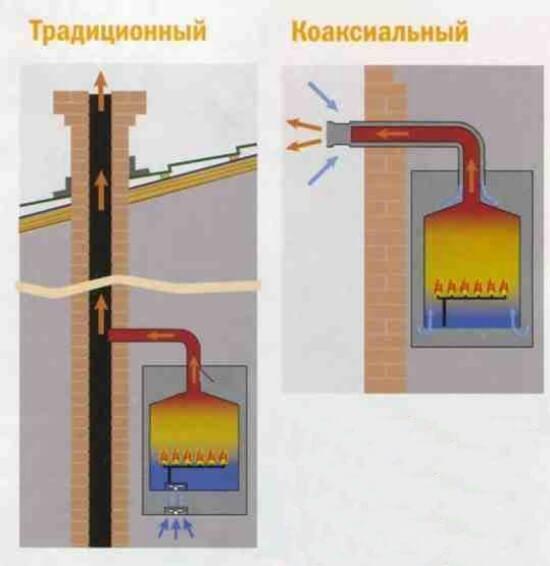
Coaxial system increases the efficiency of the heater. This is due to the fact that is supplied in the furnace the air passes through the inner cavity of the structure, heated by pipes which bring hot smoke. Another significant advantage of the chimneys of this type is the compactness and relatively small size, especially compared to traditional separate chimneys.
It would be a mistake to think that the system has no shortcomings. They are. First of all, this is a fairly high cost of this design. On average it is 40% more expensive than traditional. Another is due to the device of a flue of coaxial type. Pipes, hot smoke and cold air contact, which inevitably leads to the formation of condensation, especially in cold weather. Thus, the system needs special arrangement for draining condensate and additional insulation, which further increases the cost.
How to choose the size of the device
In the technical documentation, which is attached to the chimney, must indicate its diameter. The designation consists of two numbers separated by a fraction. The first one shows the diameter of the inner tube, the second outer. Find the right size quite easily. It needs to be specified in the passport of the boiler, which will be connected to this chimney.
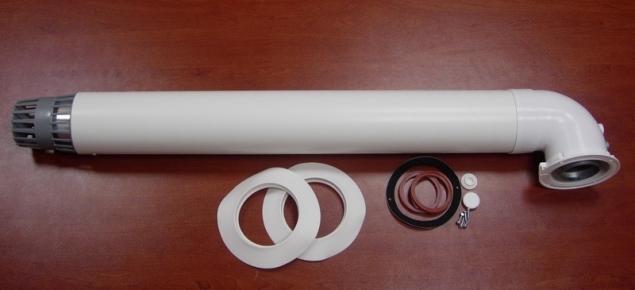
The determining factor in this case is not only the diameter, but its length. The latter is defined as the sum of the lengths of all sections of the chimney. It has limitations, documented in the Assembly instructions, and is measured in equivalent metres. In addition, all these nuances are indicated in the selection table, which should be attached to the technical documentation of the heating equipment.
Installation of chimney in the light of the regulations
Discharging smoke system of coaxial type can be installed in private or apartment house. The latter is also quite common, especially in connection with the widespread installation of individual heating systems in apartments. Until 2012, the design and installation of chimneys coaxial type in apartment buildings and private houses were regulated by a single SNP and did not differ.
In 2012 was adopted a set of rules SP 60.13330.2012, which represents an actualized edition of SNiP 41-01-2003. The document was shared conditions of installation of the coaxial chimney in individual and apartment building. In the latter case, it is prohibited to set individual smoke extraction systems in the apartments, as it was allowed before, and requires the installation of a collective chimney.
So you need to be very careful and know that if the designers offer to equip an individual exhaust from the heat source, located in one of the apartments of an apartment house, is contrary to the regulations in force. The distance from the ridge of the roof of the construction to section fume channel has to be at least 1.5 m. the Same value for a private home is 0.5 m.

Special acts relating to individual buildings was not accepted, therefore it is considered that their arrangement must not be inconsistent with requirements applied during the installation of chimneys in apartment buildings. Based on the new edition of building codes, in private homes can be installed coaxial systems of any type. In an apartment, but vertical.
Important nuance. If the building up to 2012 were installed chimneys, contrary to the current edition, they can be left unchanged in that case, if you do not cause annoyance to neighbours.
Some features of installation
For each boiler the direction of the channel, diverting the combustion products is determined individually. The horizontal system can only be used for devices with forced ventilation.
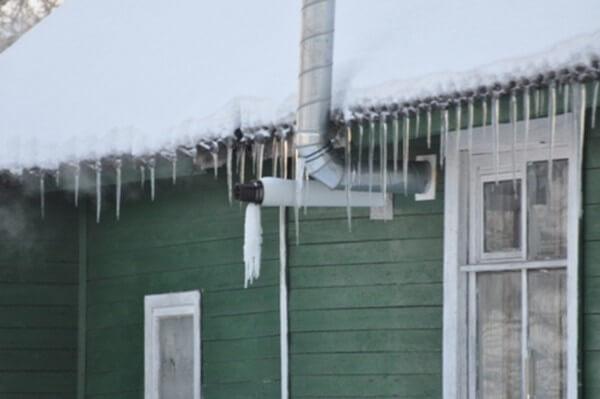
But in this case, the maximum length of such a section should not be more than 3 m. it Happens that the manufacturer sets other standards for their boilers, so you should read the technical documentation of the device.
Design vertical type for private homes are used only if there are reasons preventing the withdrawal chimney channel through the wall. It can be close to the output tube window, a narrow street, on which stands the building, and the like. In some cases, if it is very necessary allowed to the inclined installation of the coaxial chimney.

System connection to the heater is performed with a tee, elbows or pipe. The diameters of the offtake and outlet of the boiler should be the same. During the installation process, all subsequent details are fixed in the preceding so as to form barriers that can disrupt the flow of products of combustion. The number and type of elements for Assembly directly dependent on the location of the outlet pipe.
If it is sideways, it is assumed arrangement of the horizontal system, if the top – vertical. The latter is more easy to install. In the process of resettlement of the coaxial flue be sure to use transition nodes with rigid fastening sections of the junction of the two elements with clamps. Some "craftsmen" prefer to use homemade versions.
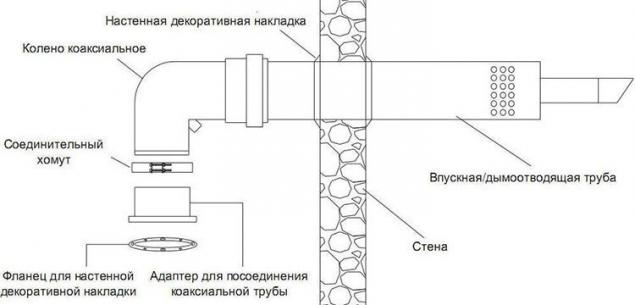
It can be self-made adapter, the winding of the tape or seal of the sealant. Such things are not allowed to use because it is unreliable. The system collected through the use of such elements is considered to be unsafe. In addition, the installation process follow the next rules:
All design elements should fit snugly to each other. Each subsequent part should go inside the previous at a distance equal to not less than half the diameter of the channel cross section. To circle design around any obstacles are specially designed for this knee. The angle of inclination may be different. If the system is excreted through the roof, you need to follow all fire safety requirements.
With this purpose, a special insulating pipes and combustible insulation materials. Between the pipe and the ceiling must be air gap. To prevent contact between the fume collection channel and fragments of roofing use a protective cover. Design output through the roof are thoroughly sealed. Parts of the joints are covered by special apron.
Technology of installation of coaxial chimney
The process of installation of external and internal coaxial flue is different. Consider both options.
Installation of the internal system
First of all check the corresponding diameter of the outlet pipe of the boiler and the chimney. Then start preparing the holes in the wall through which the chimney will go out. Its diameter must exactly match the dimensions of the coaxial pipe. After making a hole, you can begin installation. It begins with the outlet of the boiler, to which is attached the corresponding element of the chimney.
The resulting connection is fixed with a clamp and secured with two bolts. Next, assemble the entire structure. Each element is inserted into place and secured by means of special clamps in order to give the system additional reliability. On top of the mounts installed decorative overlays, remains the attractive appearance of the structure.
The chimney out through the wall into the street. If necessary, the output tube is set to vent or additional protection from the wind. The section of the passage in the wall is closed up. While the requirements of fire safety. The pipe is put a special protective cover. The joints of the aisle are sealed and covered by the apron.

Installation of outdoor design
Before determine the output of the coaxial flue and set its location on the wall of the building. Then hole in the wall with a diameter corresponding to the cross section of the fume channel. Next are all the domestic work. Start with pipe joint with the heating device. To do this, use single-circuit and double-circuit knee tee.
The latter is necessary to secure the structure in an upright position. The resulting structure is fixed on the surface of the wall with special brackets. Further, all work is carried out similarly to the above-described method. The region of the exit of the chimney is closed up and continuing Assembly of the pipe to the desired height. The structure is fixed to the wall with clamps. For connecting the dual tubes are used transient nodes.
Installation of the flue of coaxial type in a wooden house
How to install the coaxial flue
The chimney coaxial type – effective and practical device that significantly increases the efficiency of the heater. In addition, it is absolutely safe in operation, compact and simply to install. The only significant disadvantage is the relatively high cost of arranging such a system, which, however, pays off its long-term effective work. published
Source: sovet-ingenera.com/otoplenie/otop-oborudovanie/montazh-koaksialnogo-dymoxoda.html
Coaxial duct: what is itIn the technique the term "coaxial" means that there are two objects of any kind, arranged so that one is inside the other. Therefore, the coaxial type chimney is a double-loop construction, made of pipes of different diameters. Inside the larger element is less detail. The distance between them is strictly the same throughout the length of the design, including all bends and elbows.

To this end, the tubes are a special jumper. In the context of such a system looks like a pair of concentric rings. Channel for the removal of smoke is the inner, smaller diameter pipe. Through a gap between two parts inside of the heater from outside is supplied is required to support combustion oxygen. Thus, gases within the system are moved in opposite directions.
Design features of the coaxial flue and give him the opportunity to perform direct functions. The device provides a constant flow of air that is needed to sustain the combustion process. In addition, it successfully removes from the boiler the products of combustion. With an overall length of usually less than two metres. This files most often mounted system, oriented horizontally, but some vertical variation.

The chimney of the coaxial type is a system of modules that allows you to make chimneys of various configurations taking into account the architectural features of the building. All the elements included in the system are standardized, which greatly simplifies their installation.
The standard package consists of several modules:
For the manufacture of parts for coaxial ducts are used galvanized or stainless steel. It is resistant to high temperatures, durable and lightweight. Some models are made of aluminium alloy or heat-resistant plastic. For joints, apply the sealers made of heat-resistant polymers capable of withstanding temperatures of the order of 230-250°.

Types of chimneys coaxial type
There are several types of design "pipe in pipe". A detailed look at each of them.
External and internal systems
All coaxial chimneys depending on their location divided into external and internal. The first are on the outside of the building and are fixed directly on the facade. Given that such designs are somewhat spoil the appearance of the building, they try to place on the inner sides of the building. A distinctive feature of the chimney external type – easy maintenance and installation.
Internal structure mounted in a specially laid mines that take place inside the building and is separated from the living quarters. In some cases, as these mines can be used in traditional chimneys. It is important that their design and dimensions fully meet the modern requirements of fire safety. The internal system is quite complicated to operate and install.
Non-insulated and insulated devices
In the cold, especially in extreme cold, the canal, feeding into the system the air can freeze. In this case, the amount of oxygen entering the combustion chamber is dramatically reduced, which leads to deterioration of the heater. In some cases, to stop. Therefore, where low temperatures last for quite a long period of time, and where frequent winter frosts, it is recommended to install insulated system.

Coaxial duct insulated type different from the presence of another pipe. The system looks like three nested in each other part. The space between the two extreme elements is insulated. To this end, it is filled with any suitable insulation. This protects the air passage from icing and freezing.
Horizontal or vertical output
Initially, coaxial chimneys designed as a horizontally oriented system, but in practice this arrangement is not always possible. Most of the chimneys of this type represent a mixed design. They can be vertically oriented, and horizontal sections. This is due to the location of the heater in the building. In some cases it is possible to use vertical chimneys, but only for boilers without forced draft.
Collective and individual designs
For service one heating device uses individual coaxial chimneys. It is a simple system without branching, which may have a different configuration. For multiple boilers mounted a collective chimney. This silo system with multiple branches. In addition, each of the branches goes to one of the heat generators. This design can only be vertical.

Why choose coaxial system
Design features of the coaxial flue and give him the opportunity to work non-traditional chimney principle. To ensure that the combustion in the boiler furnace must be supplied oxygen, and the products of combustion are discharged. Boilers equipped with separate flues take the air out of the room in which installed. It is quite dangerous to humans and requires continuous ventilation.
Exhaust gases discharged through a natural draught out. Devices with coaxial chimneys work differently. These chimneys represent a combined air supply system and fume. Necessary for the operation of the thrust device is created naturally or with a fan that allows you to use a small length of the design.

Thus, the complete isolation of the tap of products of combustion and oxygen supply gives you the opportunity to completely eliminate their impact on the composition of the air in the room where the boiler is installed. The "burning" of oxygen occurs, which does not require room ventilation. The amount of air in the combustion chamber optimally, which increases the percentage of fuel combustion and, as a result, the boiler runs more efficiently and environmentally friendly.
Hot smoke from a heating appliance are given in the inner tube. It goes inside the other, which moves the cold air. Thus, there is no thermal effect on the walls and floors, which are laid inside the chimney. This greatly enhances its fire safety, which is very important for buildings that are made of wood and other very flammable materials.

Coaxial system increases the efficiency of the heater. This is due to the fact that is supplied in the furnace the air passes through the inner cavity of the structure, heated by pipes which bring hot smoke. Another significant advantage of the chimneys of this type is the compactness and relatively small size, especially compared to traditional separate chimneys.
It would be a mistake to think that the system has no shortcomings. They are. First of all, this is a fairly high cost of this design. On average it is 40% more expensive than traditional. Another is due to the device of a flue of coaxial type. Pipes, hot smoke and cold air contact, which inevitably leads to the formation of condensation, especially in cold weather. Thus, the system needs special arrangement for draining condensate and additional insulation, which further increases the cost.
How to choose the size of the device
In the technical documentation, which is attached to the chimney, must indicate its diameter. The designation consists of two numbers separated by a fraction. The first one shows the diameter of the inner tube, the second outer. Find the right size quite easily. It needs to be specified in the passport of the boiler, which will be connected to this chimney.

The determining factor in this case is not only the diameter, but its length. The latter is defined as the sum of the lengths of all sections of the chimney. It has limitations, documented in the Assembly instructions, and is measured in equivalent metres. In addition, all these nuances are indicated in the selection table, which should be attached to the technical documentation of the heating equipment.
Installation of chimney in the light of the regulations
Discharging smoke system of coaxial type can be installed in private or apartment house. The latter is also quite common, especially in connection with the widespread installation of individual heating systems in apartments. Until 2012, the design and installation of chimneys coaxial type in apartment buildings and private houses were regulated by a single SNP and did not differ.
In 2012 was adopted a set of rules SP 60.13330.2012, which represents an actualized edition of SNiP 41-01-2003. The document was shared conditions of installation of the coaxial chimney in individual and apartment building. In the latter case, it is prohibited to set individual smoke extraction systems in the apartments, as it was allowed before, and requires the installation of a collective chimney.
So you need to be very careful and know that if the designers offer to equip an individual exhaust from the heat source, located in one of the apartments of an apartment house, is contrary to the regulations in force. The distance from the ridge of the roof of the construction to section fume channel has to be at least 1.5 m. the Same value for a private home is 0.5 m.

Special acts relating to individual buildings was not accepted, therefore it is considered that their arrangement must not be inconsistent with requirements applied during the installation of chimneys in apartment buildings. Based on the new edition of building codes, in private homes can be installed coaxial systems of any type. In an apartment, but vertical.
Important nuance. If the building up to 2012 were installed chimneys, contrary to the current edition, they can be left unchanged in that case, if you do not cause annoyance to neighbours.
Some features of installation
For each boiler the direction of the channel, diverting the combustion products is determined individually. The horizontal system can only be used for devices with forced ventilation.

But in this case, the maximum length of such a section should not be more than 3 m. it Happens that the manufacturer sets other standards for their boilers, so you should read the technical documentation of the device.
Design vertical type for private homes are used only if there are reasons preventing the withdrawal chimney channel through the wall. It can be close to the output tube window, a narrow street, on which stands the building, and the like. In some cases, if it is very necessary allowed to the inclined installation of the coaxial chimney.

System connection to the heater is performed with a tee, elbows or pipe. The diameters of the offtake and outlet of the boiler should be the same. During the installation process, all subsequent details are fixed in the preceding so as to form barriers that can disrupt the flow of products of combustion. The number and type of elements for Assembly directly dependent on the location of the outlet pipe.
If it is sideways, it is assumed arrangement of the horizontal system, if the top – vertical. The latter is more easy to install. In the process of resettlement of the coaxial flue be sure to use transition nodes with rigid fastening sections of the junction of the two elements with clamps. Some "craftsmen" prefer to use homemade versions.

It can be self-made adapter, the winding of the tape or seal of the sealant. Such things are not allowed to use because it is unreliable. The system collected through the use of such elements is considered to be unsafe. In addition, the installation process follow the next rules:
All design elements should fit snugly to each other. Each subsequent part should go inside the previous at a distance equal to not less than half the diameter of the channel cross section. To circle design around any obstacles are specially designed for this knee. The angle of inclination may be different. If the system is excreted through the roof, you need to follow all fire safety requirements.
With this purpose, a special insulating pipes and combustible insulation materials. Between the pipe and the ceiling must be air gap. To prevent contact between the fume collection channel and fragments of roofing use a protective cover. Design output through the roof are thoroughly sealed. Parts of the joints are covered by special apron.
Technology of installation of coaxial chimney
The process of installation of external and internal coaxial flue is different. Consider both options.
Installation of the internal system
First of all check the corresponding diameter of the outlet pipe of the boiler and the chimney. Then start preparing the holes in the wall through which the chimney will go out. Its diameter must exactly match the dimensions of the coaxial pipe. After making a hole, you can begin installation. It begins with the outlet of the boiler, to which is attached the corresponding element of the chimney.
The resulting connection is fixed with a clamp and secured with two bolts. Next, assemble the entire structure. Each element is inserted into place and secured by means of special clamps in order to give the system additional reliability. On top of the mounts installed decorative overlays, remains the attractive appearance of the structure.
The chimney out through the wall into the street. If necessary, the output tube is set to vent or additional protection from the wind. The section of the passage in the wall is closed up. While the requirements of fire safety. The pipe is put a special protective cover. The joints of the aisle are sealed and covered by the apron.

Installation of outdoor design
Before determine the output of the coaxial flue and set its location on the wall of the building. Then hole in the wall with a diameter corresponding to the cross section of the fume channel. Next are all the domestic work. Start with pipe joint with the heating device. To do this, use single-circuit and double-circuit knee tee.
The latter is necessary to secure the structure in an upright position. The resulting structure is fixed on the surface of the wall with special brackets. Further, all work is carried out similarly to the above-described method. The region of the exit of the chimney is closed up and continuing Assembly of the pipe to the desired height. The structure is fixed to the wall with clamps. For connecting the dual tubes are used transient nodes.
Installation of the flue of coaxial type in a wooden house
How to install the coaxial flue
The chimney coaxial type – effective and practical device that significantly increases the efficiency of the heater. In addition, it is absolutely safe in operation, compact and simply to install. The only significant disadvantage is the relatively high cost of arranging such a system, which, however, pays off its long-term effective work. published
Source: sovet-ingenera.com/otoplenie/otop-oborudovanie/montazh-koaksialnogo-dymoxoda.html
